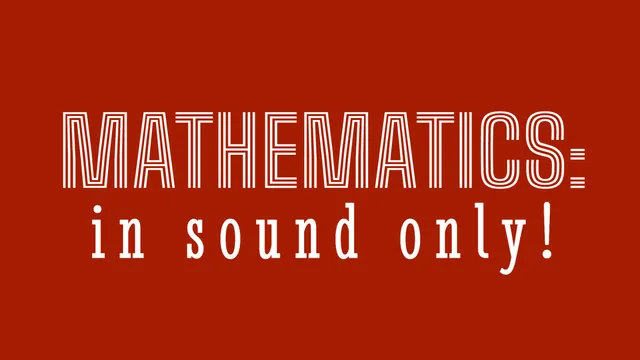Mathematics: In Sound Only! Logarithms
Audience: high-schoolundergraduate
Tags: audio
I have created an audio program intended for an enthusiast audience, using the logarithmic perception of pitch as a metaphor to explain logarithms and the exponential function. My intention is to explore sonic metaphors, which I feel are underused in maths education, and to attempt to improve access for blind and partially sighted people.
Analytics
Comments
Unique! I think it might be better as a video with some visualization - also, how did you build this? Could you like to the tool in the description please.
I really liked this! I’m not sure how clear the explanation would be if I wasn’t such a math enthusiast but I appreciated it like an interesting podcast. The connection between exponents and scale was pretty neat. I would say lead more with musical notes if possible because the beginning was a little wordy. Otherwise well done!
Visualization would be the key for this entry.
Very good leading pitch. I’m not a huge podcast/audio content guy, but I think you’ve used frequency quite smartly to “show” your examples. I’m not quite sure how novel this approach is, but it is executed here quite well. The pure synthesized pitches are fairly shrill; this is a double-edge sword, as any post-processing would literally change the numbers. I’m not sure of how to address this, but at times it was difficult to listen to due to the harsh pitch. In spite of the pitch, I did really like how simple repeating tones culminated to notes and cords. I’d be interested to see how the blind interpret this work.
Pace was a little slow. Loved the clicking to tone, that was an audible mathematical insight. It’s tempting to request audio plus visuals, but perhaps the brain is more “active” without it, ala the old listening to the radio or reading a book rather than passively watching a screen :-)
As a teaching resource, I would only use this in a unit on music or sound, not when trying to introduce the logarithm. The format felt novel. It made it easier to focus on the notes that were being played and what they sounded like without being distracted by a visual. However, I think that the audio only format made it hard to understand the information about the logarithm (especially for a student unfamiliar with the concept). I think this could be improved by focusing exclusively on the connection to music and making that the primary topic, rather than trying to make the main topic logarithms and explaining them along the way.
The idea of a sound only entry is obviously really original. I was very excited on this, but had a hard time following because of the amount of music concepts that I believe are taken for granted. I think I started to be lost when perfect fifths were mentioned. I don’t really know much about music.
I’m sorry if I didn’t make enough efforts into understanding, but I think I would have liked a slower pace. In particular, the only part I could somehow follow was the twice pitch ‘proof’ of making the frequencies faster, but even this I think would benefit of being a bit longer. A lot of the sound demonstrations feel too short for me to follow.
I really just give this grade because I can see the amount of effort that has gone into preparing this entry, and I know hopefully there is a target audience in the intersection between math and music, which is sadly not me at the moment. Keep going!
Good demonstration of how sound is perceived logarithmically and not arithmetically.
- The song at the end was somewhat confusing for demonstrating that going up an octave is equivalent to doubling the frequency; on the moments when you say “two fold”, “four fold”, “eight fold”, etc. the music does not go up by octaves but instead by a diatonic chord progression (in the keys C, Bb, Ab, G, F, Eb, Db, C major). You could instead just play octaves.
- It would also help to show what arithmetically rising frequencies sound like (the harmonic series), in order to demonstrate that the perceived separation between adjacent frequencies is not even, contrary to what intuition would expect.
I never thought it would be possible to convey maths and music theory using an audio-only medium, but you’ve managed to pull it off extremely well!
This was a neat survey of history, music theory and the underlying mathematics in music. It was really beautiful to hear exponential growth, it made my heart rate go faster. This audio content presented a fast pace and tuning into this survey had me wonder about the sequence of transitions you’ve exhibited. I’d love to tune in if you decide to create future episodes. Some feedback is to break down parts of this survey with more history and examples. For example, you explained logarithms as a theme, and somewhere in between we dove into irrational numbers via example of sqrt(2), then to a log’s partner, the exponential. Also, can you answer in a future episode what mathematics you’ve implemented in the background score of this first episode? Thanks and please make more content!
The Ranking score is an average of these individual categories, good luck! Motivation: 9 Clarity: 7 Novelty: 9 Memorability: 9
The explanation required a lot of music vocabulary and more intuition about music than the average person has. More explanation or warning of what concepts you’d need to be familiar with to get something from the explanation would be useful.
Good idea in theory. I think it could have been improved by more signposting, and visualisations.
